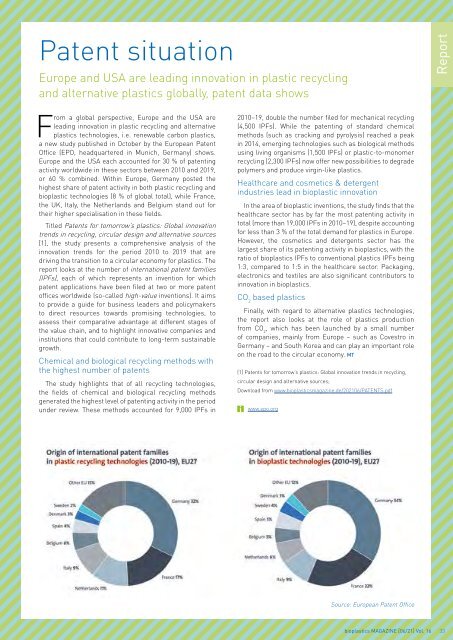Issue 06/2021
Highlights: Coating Films, Flexibles, Bags Basics: Cellulose based bioplastics
Highlights:
Coating
Films, Flexibles, Bags
Basics: Cellulose based bioplastics
You also want an ePaper? Increase the reach of your titles
YUMPU automatically turns print PDFs into web optimized ePapers that Google loves.
Patent situation<br />
Europe and USA are leading innovation in plastic recycling<br />
and alternative plastics globally, patent data shows<br />
Report<br />
From a global perspective, Europe and the USA are<br />
leading innovation in plastic recycling and alternative<br />
plastics technologies, i.e. renewable carbon plastics,<br />
a new study published in October by the European Patent<br />
Office (EPO, headquartered in Munich, Germany) shows.<br />
Europe and the USA each accounted for 30 % of patenting<br />
activity worldwide in these sectors between 2010 and 2019,<br />
or 60 % combined. Within Europe, Germany posted the<br />
highest share of patent activity in both plastic recycling and<br />
bioplastic technologies (8 % of global total), while France,<br />
the UK, Italy, the Netherlands and Belgium stand out for<br />
their higher specialisation in these fields.<br />
Titled Patents for tomorrow’s plastics: Global innovation<br />
trends in recycling, circular design and alternative sources<br />
[1], the study presents a comprehensive analysis of the<br />
innovation trends for the period 2010 to 2019 that are<br />
driving the transition to a circular economy for plastics. The<br />
report looks at the number of international patent families<br />
(IPFs), each of which represents an invention for which<br />
patent applications have been filed at two or more patent<br />
offices worldwide (so-called high-value inventions). It aims<br />
to provide a guide for business leaders and policymakers<br />
to direct resources towards promising technologies, to<br />
assess their comparative advantage at different stages of<br />
the value chain, and to highlight innovative companies and<br />
institutions that could contribute to long-term sustainable<br />
growth.<br />
Chemical and biological recycling methods with<br />
the highest number of patents<br />
The study highlights that of all recycling technologies,<br />
the fields of chemical and biological recycling methods<br />
generated the highest level of patenting activity in the period<br />
under review. These methods accounted for 9,000 IPFs in<br />
2010–19, double the number filed for mechanical recycling<br />
(4,500 IPFs). While the patenting of standard chemical<br />
methods (such as cracking and pyrolysis) reached a peak<br />
in 2014, emerging technologies such as biological methods<br />
using living organisms (1,500 IPFs) or plastic-to-monomer<br />
recycling (2,300 IPFs) now offer new possibilities to degrade<br />
polymers and produce virgin-like plastics.<br />
Healthcare and cosmetics & detergent<br />
industries lead in bioplastic innovation<br />
In the area of bioplastic inventions, the study finds that the<br />
healthcare sector has by far the most patenting activity in<br />
total (more than 19,000 IPFs in 2010–19), despite accounting<br />
for less than 3 % of the total demand for plastics in Europe.<br />
However, the cosmetics and detergents sector has the<br />
largest share of its patenting activity in bioplastics, with the<br />
ratio of bioplastics IPFs to conventional plastics IPFs being<br />
1:3, compared to 1:5 in the healthcare sector. Packaging,<br />
electronics and textiles are also significant contributors to<br />
innovation in bioplastics.<br />
CO 2<br />
based plastics<br />
Finally, with regard to alternative plastics technologies,<br />
the report also looks at the role of plastics production<br />
from CO 2<br />
, which has been launched by a small number<br />
of companies, mainly from Europe – such as Covestro in<br />
Germany – and South Korea and can play an important role<br />
on the road to the circular economy. MT<br />
[1] Patents for tomorrow’s plastics: Global innovation trends in recycling,<br />
circular design and alternative sources;<br />
Download from www.bioplasticsmagazine.de/<strong>2021</strong><strong>06</strong>/PATENTS.pdf<br />
www.epo.org<br />
Source: European Patent Office<br />
bioplastics MAGAZINE [<strong>06</strong>/21] Vol. 16 33

















